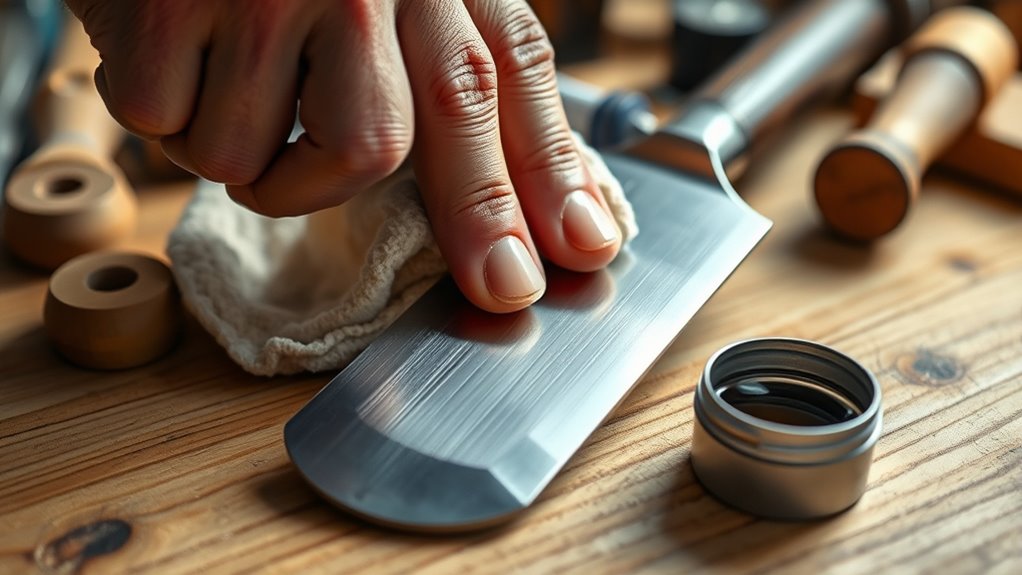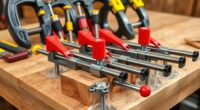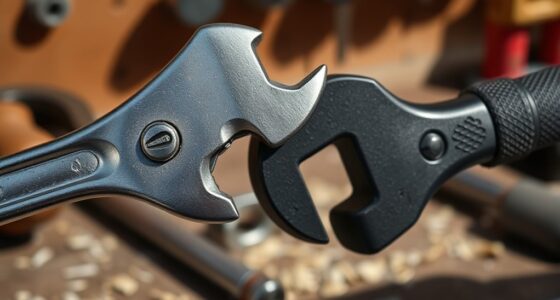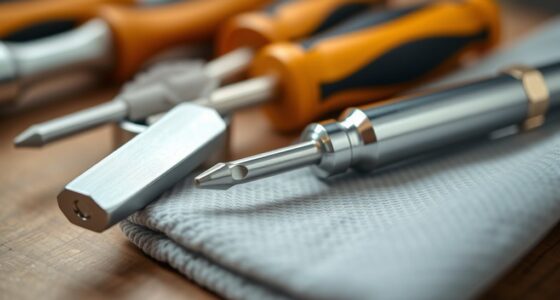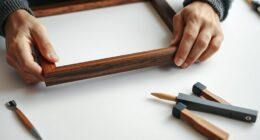To care for your wood chisels, clean them after each use by wiping the blades and handles with a dry or damp cloth. Regularly sharpen and hone the blades with proper stones at the correct bevel angle to keep them sharp. Use protective caps or sheaths to prevent damage and inspect for any damage or rust. Lubricate wooden handles with light oil to prevent cracking, and store tools in a dry, organized space. Keep learning for more tips on maintaining your chisels in top shape.
Key Takeaways
- Wipe blades with a dry cloth after use to remove dust and debris.
- Regularly sharpen and hone blades to maintain cutting efficiency and prevent dullness.
- Apply a light coat of oil to blades and handles to prevent rust and cracking.
- Store chisels in a dry, cool place, preferably upright or hanging, with protective sheaths.
- Inspect blades and handles periodically for damage, and address issues promptly for safety and longevity.
Regular Cleaning After Use
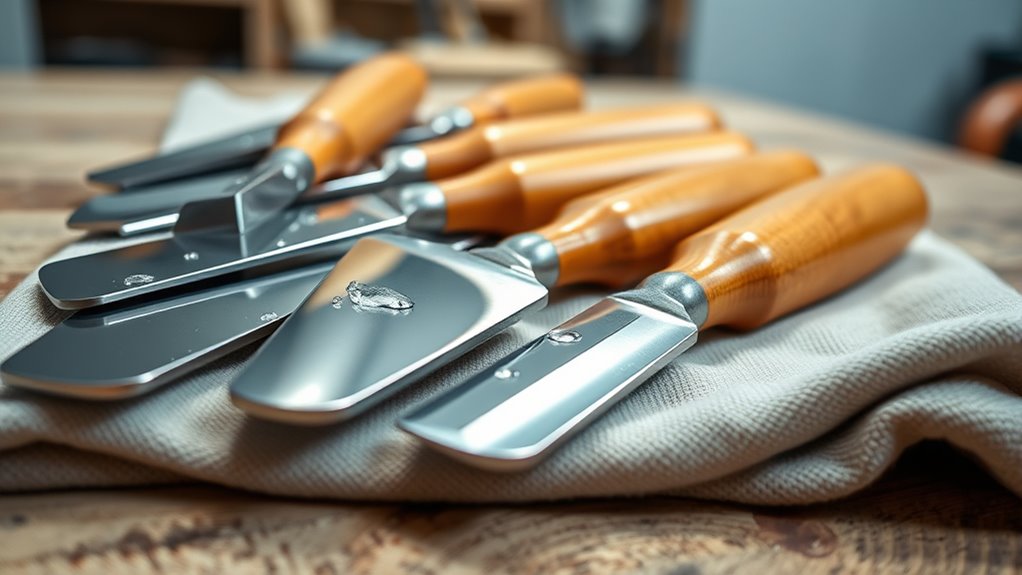
After you finish using your wood chisel, it is vital to clean it promptly to prevent rust and buildup. Start by wiping the blade with a clean, dry cloth to remove wood dust and debris. Pay attention to the wood grain, as particles can lodge in the grooves, affecting performance. If needed, use a slightly damp cloth to clean stubborn residue, then dry the blade thoroughly. Don’t forget about the chisel handles—whether wooden or synthetic, wipe them down to keep them in good shape. Wooden handles, in particular, benefit from light oiling to prevent drying out or cracking. Regular cleaning keeps your chisel sharp and in prime condition, ensuring precise cuts and extending its lifespan. Incorporating proper maintenance practices can further enhance the longevity of your tools.
Proper Sharpening Techniques
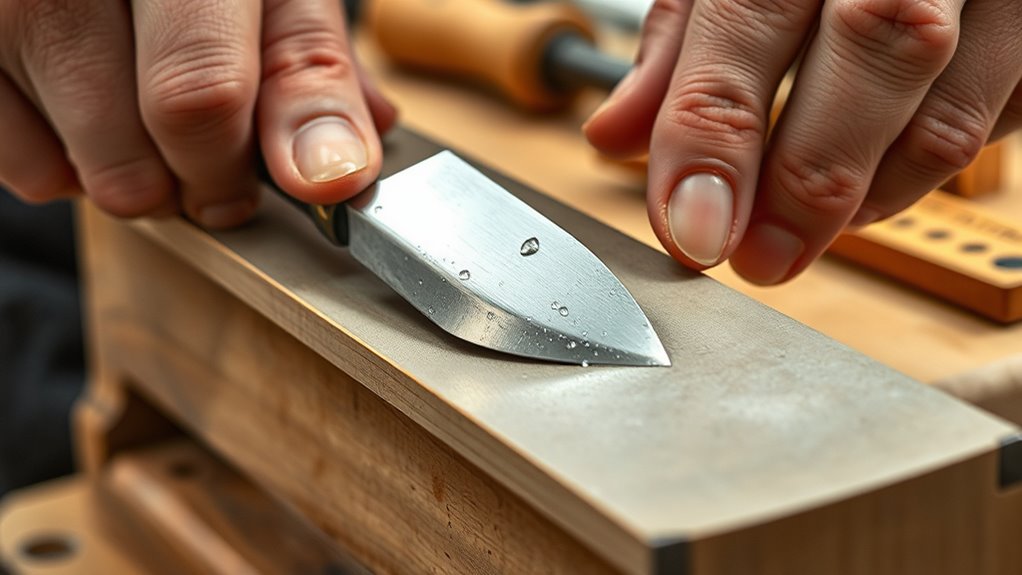
To keep your chisels sharp, you need to choose the right sharpening stone for your tool. Maintaining the correct angle while honing guarantees a clean, precise edge. Focus on honing consistently to achieve and preserve that razor-sharp finish.
Selecting the Right Stone
Choosing the right stone is essential for achieving a sharp and durable edge on your wood chisel. When it comes to stone selection, consider the type of sharpening stones that suit your needs. Coarse-grit stones quickly reshape dull edges, while fine-grit stones refine and hone the edge for smooth cuts. Look for sharpening stones made from high-quality materials like water stones or oil stones, which provide consistent results. The size and hardness of the stone also matter; larger stones offer more surface area, making the process faster. Remember, selecting the proper sharpening stones guarantees efficient sharpening and prolongs your chisel’s life. Investing in quality stone selection is crucial because professional voiceovers often emphasize the importance of high-quality tools for optimal results, ensuring your sharpening process becomes quicker and more effective.
Maintaining the Correct Angle
Maintaining the correct angle is essential for achieving a sharp, long-lasting edge on your wood chisel. Proper blade alignment guarantees your edge is even and effective, preventing uneven wear. To adjust the angle, start by positioning the bevel flat against your sharpening stone, then tilt it to your desired bevel angle, typically around 25 to 30 degrees. Check the angle adjustment frequently as you sharpen, making small tweaks to keep the blade aligned correctly. Consistent blade alignment during sharpening ensures uniform edge formation and prevents dull spots. Remember, maintaining the correct angle not only sharpens your chisel efficiently but also extends its lifespan. Focus on steady, deliberate movements to preserve the proper angle throughout the process, leading to a cleaner, sharper edge. Regular maintenance and proper technique also contribute to the overall appliance longevity of your tools.
Honing for Sharpness
Honing your wood chisel is essential for achieving a razor-sharp edge, and proper sharpening techniques make all the difference. Begin by examining the chisel’s edge, ensuring it aligns with the correct angle. Use a sharpening stone or honing guide to maintain a consistent angle, paying attention to the wood grain on the edge. As you hone, keep your chisel handle steady and comfortable, avoiding pressure that could damage the blade. Work evenly across the bevel, applying light, deliberate strokes. Frequently check the edge for a burr or a mirror-like polish, indicating sharpness. Remember, consistent honing not only sharpens the chisel but also prolongs its life. Proper technique guarantees your chisel remains effective and safe for precise woodworking. AI-driven solutions are increasingly influencing tools and techniques in woodworking, enhancing precision and efficiency.
Choosing the Right Honing Stones
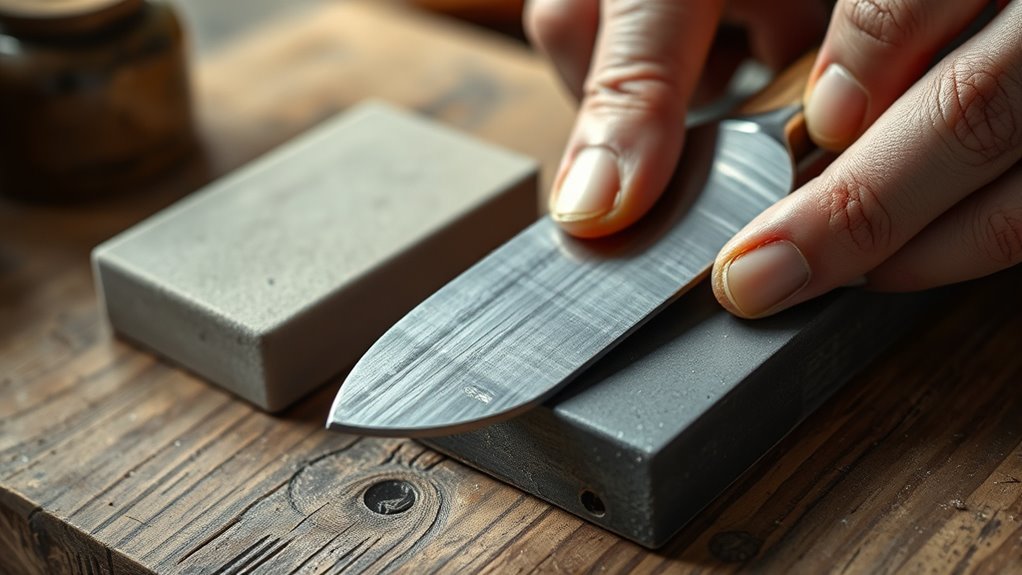
Selecting the right honing stones is essential to achieving a sharp, durable edge on your wood chisels. Start by understanding honing stone types, which include oil stones, water stones, and diamond stones. Each type offers different benefits: oil stones are durable and affordable, water stones cut quickly and require soaking, while diamond stones are fast and versatile. Grit selection is equally important; coarse grit (around 220-400) is ideal for reshaping dull edges, while medium (600-1000) and fine grits (2000 and above) are better for honing and polishing. Choose a combination that matches your chisels’ condition and your sharpening goals. Properly selecting honing stones ensures you achieve a sharp, long-lasting edge with less effort and greater precision. Additionally, understanding abrasive properties can help you select the most effective stones for your specific needs.
Honing and Polishing for a Sharp Edge

To keep your chisels sharp, you need to choose the right honing tools and use them properly. Effective polishing techniques will guarantee your edges stay smooth and precise. Let’s explore how to select the best tools and apply the techniques for ideal results. Incorporating proper maintenance practices such as regular honing and polishing can extend the lifespan of your chisels and ensure optimal performance.
Selecting Proper Honing Tools
Choosing the right honing tools is essential for maintaining a sharp and effective wood chisel. The key is selecting suitable honing tools and sharpening accessories that match your needs. High-quality stones, leather strops, and polishing compounds are common options. Consider the grit of the honing stones: coarse for reshaping and fine for finishing. The right tools help you achieve a precise edge efficiently.
| Honing Tools | Use |
|---|---|
| Coarse Stones | Reshape dull or damaged edges |
| Fine Stones/Polishers | Finish and refine for sharpness |
| Leather Strops | Polishing for a razor-sharp edge |
| Sharpening Accessories | Maintain and adjust your tools |
Choose wisely to keep your chisel performing at its best.
Techniques for Effective Polishing
Achieving a razor-sharp edge on your wood chisel requires precise honing and polishing techniques. To enhance surface finishing, start by using a fine abrasive stone or pad to smooth the edge. Employ consistent polishing techniques, moving the chisel in circular or sweeping motions to remove scratches and imperfections. Pay close attention to the bevel and the back of the blade, ensuring even contact. Use honing compounds or polishing pastes for a final, mirror-like finish that reduces friction during woodworking. Proper surface finishing not only improves cutting efficiency but also prolongs the life of your chisel. Regular polishing keeps the edge sharp, making your work cleaner and safer. Additionally, understanding the resources and tools available can help you select the best materials for maintenance. Follow these techniques diligently to achieve best results every time.
Safe Handling During Maintenance
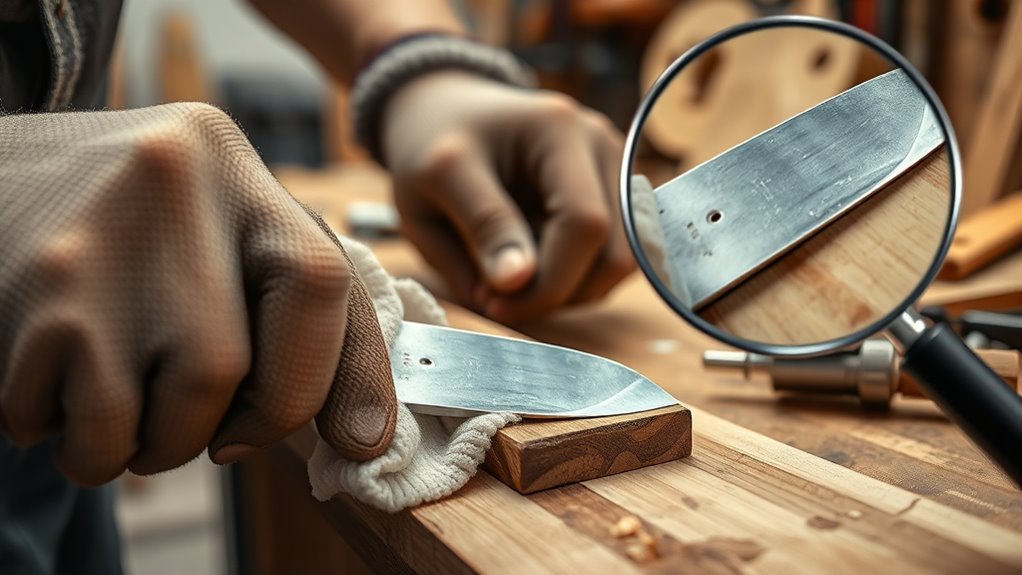
Handling your wood chisels safely during maintenance is essential to prevent injuries and keep the tools in good condition. Always prioritize safety precautions and wear protective gear like gloves and safety glasses. To ensure safe handling:
Prioritize safety and wear protective gear when maintaining wood chisels to prevent injuries.
- Secure the chisel firmly to avoid slips that could cause cuts or injuries.
- Use the right tools—never force a chisel or use damaged equipment.
- Work in a well-lit area to clearly see what you’re doing and avoid mistakes.
- Keep your hands and workspace clean to prevent accidents and mishaps.
- Consulting proper tool maintenance procedures helps ensure safe and effective care.
Storing Your Chisels Correctly
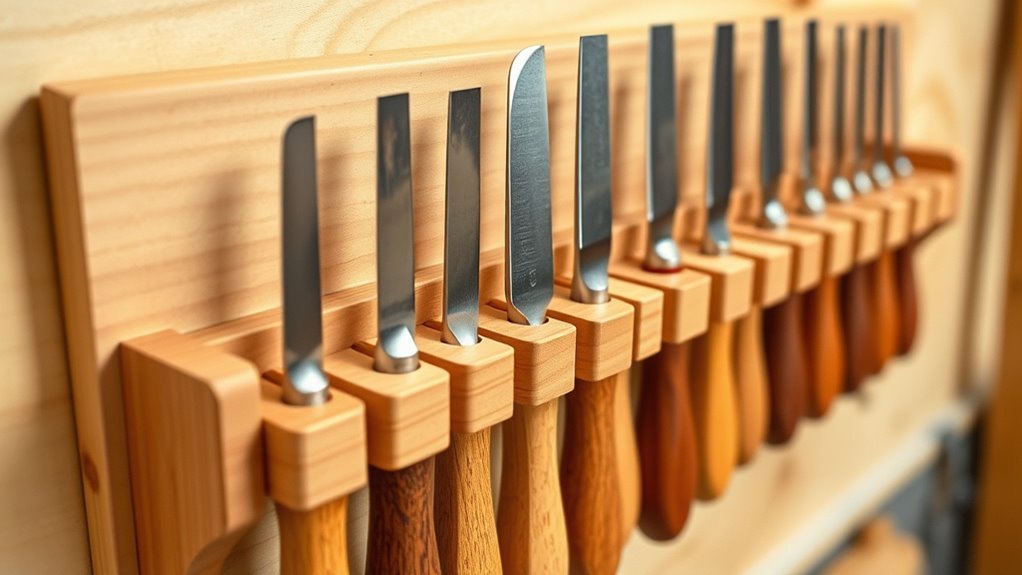
Proper storage is essential to keep your wood chisels sharp, rust-free, and ready for use. To achieve this, always store your chisels in a dry, cool place, away from humidity that can cause rust. Pay attention to the wood grain of the chisel handles; storing them upright or hanging prevents warping and keeps the handles in good condition. Avoid stacking chisels directly on top of each other, as this can dull the edges and damage the handles. Using a dedicated chisel rack or a protective sheath helps keep the blades separated and protects the handles from impact. Proper storage not only preserves the integrity of your chisels but also ensures they’re always ready for precise, safe work. Incorporating proper automation in your workshop can also streamline your maintenance routines and improve overall tool management.
Protecting the Cutting Edge With Caps or Sheaths

Protecting the cutting edge of your wood chisel is essential to maintaining its sharpness and preventing damage. Using caps or sheaths ensures blade protection and enhances storage safety. Properly sheathing your chisel guards against accidental cuts and keeps the edge from dulling or chipping. Incorporating wall organization solutions into your workspace can also help keep your tools neatly stored and easily accessible. Consider these tips: 1. Secure the sheath properly to prevent slipping during storage. 2. Choose a durable cap that fits snugly over the blade. 3. Store in a dedicated tool drawer to avoid knocking or bumping. 4. Inspect caps regularly for wear or damage, replacing when needed.
Inspecting for Damage and Wear
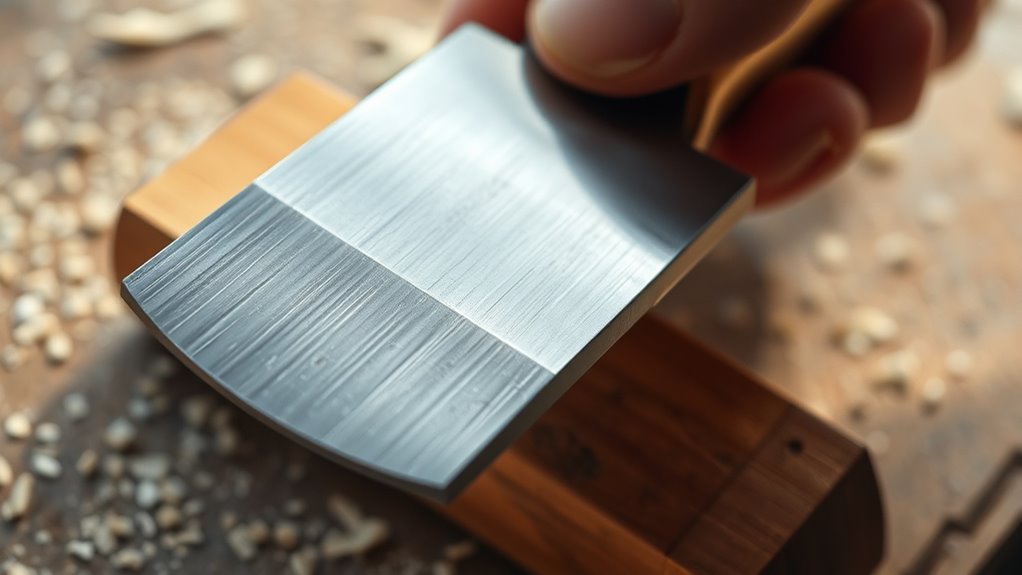
Regularly inspecting your wood chisel for damage and wear is essential to guarantee it performs safely and effectively. Check the blade for signs of dullness, chips, or cracks that could compromise its cutting ability. A dull or damaged blade reduces precision and increases safety risks, so address issues promptly. Examine the handle for cracks, splinters, or looseness, as handle integrity affects control and safety during use. If you notice any damage to the blade or handle, consider repairing or replacing the chisel to maintain maximum blade durability and handle strength. Ensuring proper tool maintenance is crucial for extending the lifespan of your chisel. Consistent inspections prevent accidents and ensure your tool remains in top condition, helping you work efficiently and safely over time.
Lubricating and Oiling Your Chisels
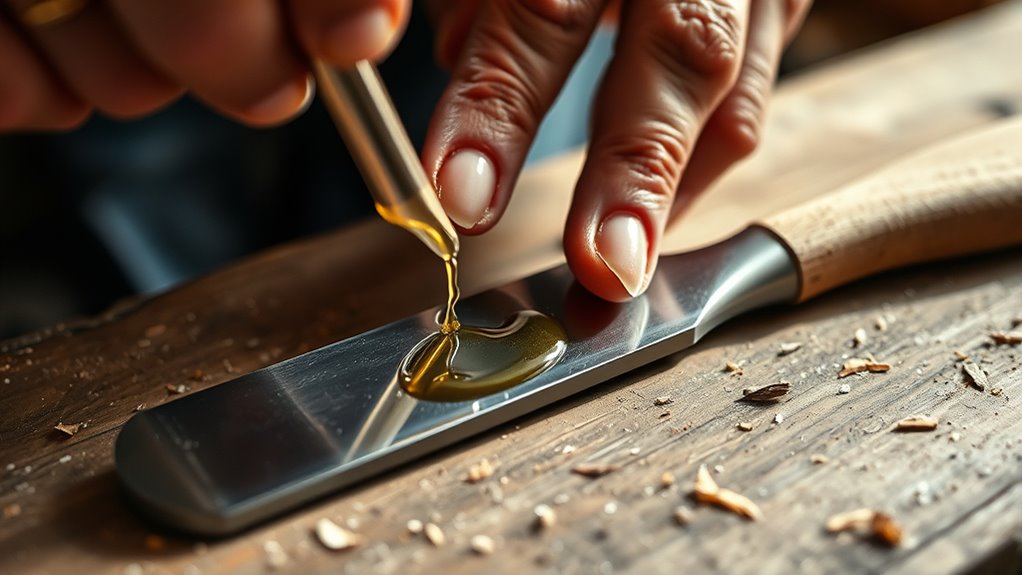
To keep your chisels in top shape, you need to use the right oil and apply it correctly. Choosing the proper lubricant assists in preventing rust and keeps the blades sharp. With simple techniques, you can ensure your chisels stay protected and ready for your next project. Regular maintenance and understanding the importance of fathers’ guidance can also inspire you to take better care of your tools.
Choosing the Right Oil
Choosing the right oil is essential for keeping your wood chisels in top condition. The right oil enhances the wood grain, highlighting its natural beauty, while also preventing rust. When selecting oil, consider how well it absorbs into the chisel’s surface and penetrates the wood grain for ideal protection. Using the appropriate materials, such as recycled or eco-friendly options, can also contribute to sustainable maintenance. Here are four key points to consider:
- Use a light mineral or camellia oil to prevent excessive buildup.
- Avoid thick, sticky oils that can clog the wood grain and hinder oil absorption.
- Choose oils that dry quickly to prevent residue from attracting dust.
- Regularly inspect and reapply oil to maintain a protective barrier against moisture.
Using the right oil ensures your chisels stay sharp, beautiful, and durable.
Proper Application Techniques
Applying oil properly to your wood chisels guarantees they stay protected and perform well over time. To do this, wipe a thin layer of oil across the blade, ensuring blade alignment remains straight. Focus on handle ergonomics by applying oil where your hand grips, preventing splinters and improving comfort. Regular lubrication prevents rust and keeps the edge sharp. Use the following table for quick tips:
| Tip | Benefit |
|---|---|
| Maintain blade alignment | Ensures precise cuts and safety |
| Oil handle regularly | Improves grip and handling comfort |
| Use light coats | Prevents residue buildup |
| Wipe excess oil | Keeps the chisel clean and rust-free |
Proper application preserves your chisels’ longevity and cutting efficiency. Additionally, understanding AI in Business can help you optimize your workshop workflow through automation and intelligent tools.
Routine Maintenance Schedule
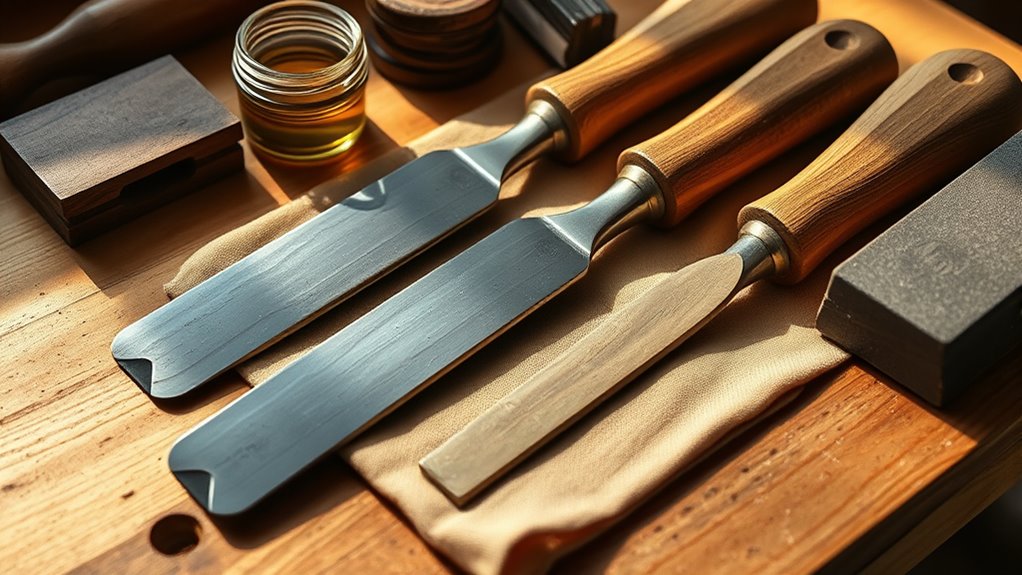
Establishing a routine maintenance schedule is essential for keeping your wood chisels in top condition. Regular care prevents damage to the wood grain and preserves the integrity of handle materials. By sticking to a schedule, you ensure your tools perform at their best and last longer. A consistent maintenance routine also helps identify potential issues early, avoiding costly repairs later. Here are four key steps to follow: 1. Sharpen your chisel edges regularly to maintain clean cuts and prevent dullness. 2. Clean the blade after each use to remove debris and prevent rust. 3. Check and tighten handle fittings, especially if handles are made from softer materials that can loosen. 4. Apply a light coat of oil to the blade to protect against moisture and corrosion. Proper care keeps your chisels reliable and safe, making every project smoother and more satisfying.
Frequently Asked Questions
How Often Should I Replace My Wood Chisels?
You might wonder how often to replace your wood chisels, but it depends on their chisel longevity and use. Usually, replacement guidelines suggest inspecting your chisels regularly for dullness, chips, or damage. If sharpening no longer restores their edge or if the blade becomes compromised, it’s time for a replacement. Proper care extends their lifespan, but when they no longer perform well, substituting them ensures safe, effective work.
Can I Use Power Tools to Sharpen My Chisels?
You might wonder if power tool sharpening is suitable for your wood chisels. While power tools can speed up the process, manual honing offers better control and precision, especially for delicate edges. Using a power tool for sharpening can risk damaging your chisels or altering their bevels. For ideal results, combine power tool sharpening for quick material removal with manual honing to refine the edge and maintain your chisels’ sharpness.
What Type of Wood Is Best for Chisel Storage?
When choosing wood for chisel storage, you want a soft, dense wood like hardwood or cedar to prevent damage. Your goal is to select a wood that offers good protection and durability. Proper storage solutions include using a wooden rack or case with individual slots, ensuring your chisels stay sharp and rust-free. By carefully selecting the right wood, you help maintain your tools’ longevity and keep them in top condition.
How Do I Prevent Rust on My Chisels?
To prevent rust on your chisels, you should regularly apply protective coatings like mineral oil or specialized rust inhibitors. Always keep your chisels dry and store them in a low-humidity environment. After use, wipe off any moisture and consider using rust-preventive products on the blades. These simple rust prevention methods help maintain sharpness and extend the lifespan of your chisels, ensuring they stay in top condition.
Are There Specific Safety Gear Recommendations for Chisel Maintenance?
Think of maintaining your chisels like handling glass; safety’s essential. You should always wear personal protective equipment, such as gloves and safety glasses, to guard against accidental slips. Proper handling during cleaning and sharpening prevents injuries and keeps your tools in top shape. I once cut myself because I skipped safety gear. Never underestimate the importance of safety gear—it’s your first line of defense when maintaining your chisels properly.
Conclusion
By following these simple tips, your wood chisels will stay sharp, safe, and ready for your next project. Think of your tools as trusted companions—worthy of care and attention. With regular cleaning, proper sharpening, and gentle handling, you’ll unleash their full potential and craft with confidence. Remember, a well-maintained chisel isn’t just a tool; it’s your partner in turning raw wood into something extraordinary. Keep them sharp, and let your craftsmanship shine.
